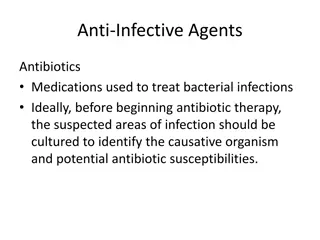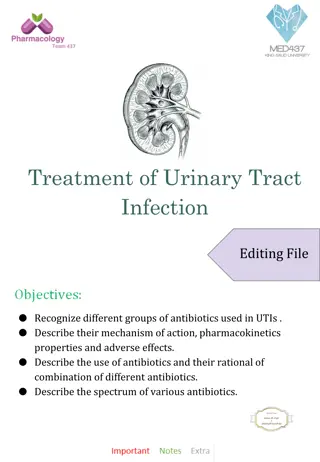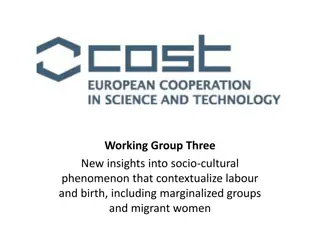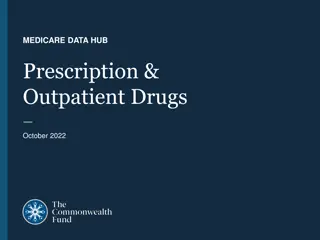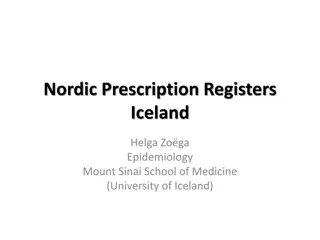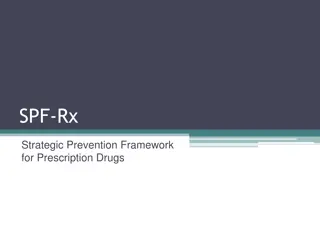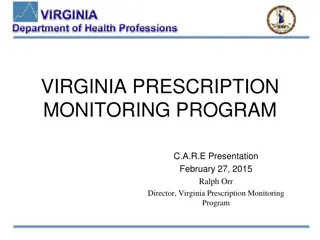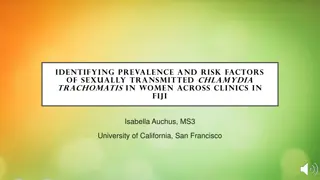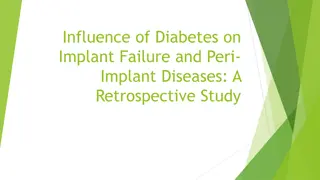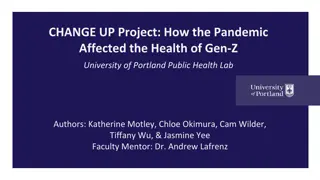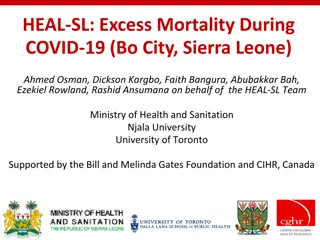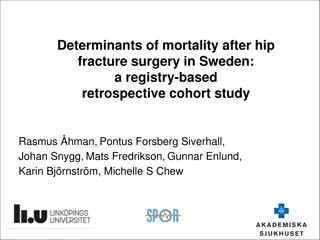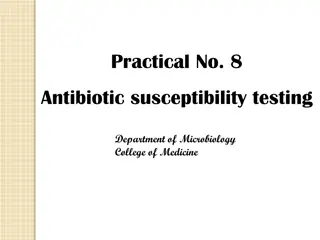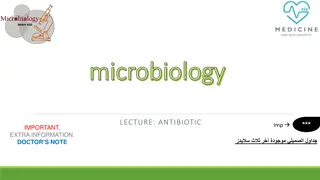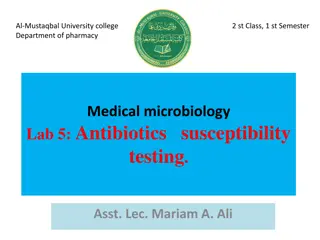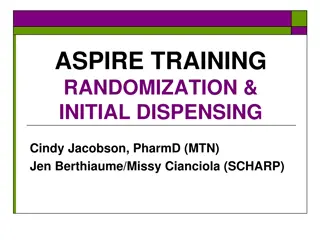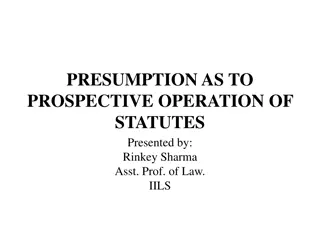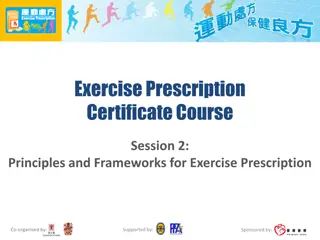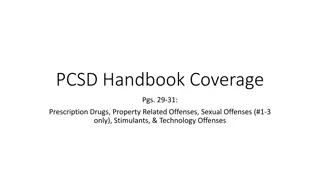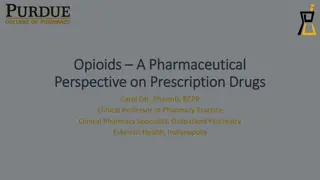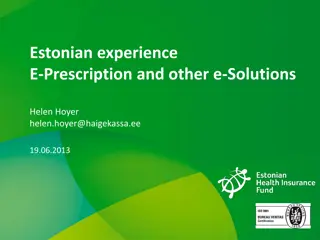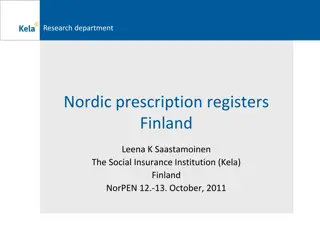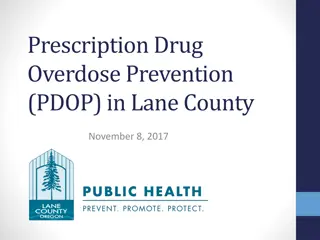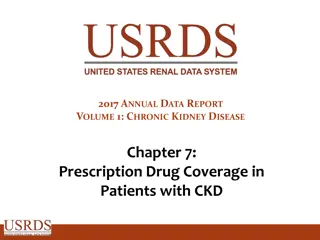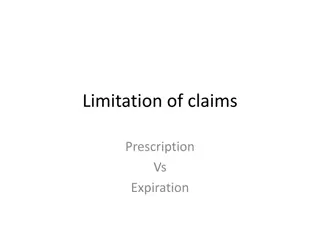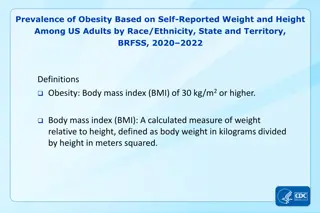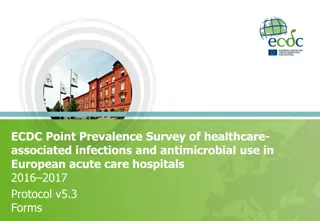Prevalence of Antibiotics Prescription Among Women During Childbirth: A Retrospective Study
This retrospective study aimed to define the prevalence and types of antibiotics prescribed, timing, and duration of prescription for mothers during childbirth at Pumwani Maternity Hospital, The Aga Khan University Hospital in Nairobi, and Kihara Sub-County Hospital. The study focused on determining if current guidelines were followed in prescribing antibiotics, with research questions on the prevalence and types of antibiotics used, differences in peripartum antibiotic use in various hospital settings in Kenya, and compliance with national guidelines. The methodology involved a quantitative retrospective chart review of maternal files from January 1 to December 31, 2019, in the specified hospitals. Initial results indicate varying rates of antibiotic use during antepartum, intrapartum, and postpartum stages.
Download Presentation

Please find below an Image/Link to download the presentation.
The content on the website is provided AS IS for your information and personal use only. It may not be sold, licensed, or shared on other websites without obtaining consent from the author. Download presentation by click this link. If you encounter any issues during the download, it is possible that the publisher has removed the file from their server.
E N D
Presentation Transcript
PREVALENCE OF ANTIBIOTICS PRESCRIPTION AMONG WOMEN DURING CHILDBIRTH IN PUMWANI MATERNITY HOSPITAL, THE AGA KHAN UNIVERSITY HOSPITAL, NAIROBI AND KIHARA SUB COUNTY HOSPITAL- A RETROSPECTIVE STUDY Author: George Ireri- KRCHN, BScM Affiliation: AKUH, N
INTRODUCTION Background: There has been a substantial rise in antimicrobial prescription and intake globally. Numerous fears have been raised concerning unwarranted use of antimicrobials and its consequent effect on antimicrobial resistance and inflated cost of healthcare (Mensah, Opoku- Agyeman, & Ansah, 2017). Maternal sepsis remains one of the leading direct causes of maternal mortality worldwide. Judicious antibiotic use can reduce morbidity and mortality. However, underuse, or ineffective regimen can be harmful to mother, newborn and increase antimicrobial resistance. Aim: The main aim of this study was to define the prevalence of and the type of antibiotics prescribed, when and the duration of the prescription among mothers admitted in The Aga Khan university hospital, Nairobi, Pumwani maternity hospital, and Kihara sub-county hospitals postnatal wards and whether current guidelines are being followed while prescribing the antibiotics.
INTRODUCTION CONT. Specific objectives To determine the prevalence of routine antibiotic use among mothers who delivered in The Aga Khan university hospital, Nairobi, Pumwani maternity hospital, and Kihara sub-county hospitals postnatal wards between a1st Jan 2019 to 31stDec 2019? To determine types of antibiotics being prescribed to mothers during childbirth Significance of the study. To determine when the antibiotics are being prescribed during childbirth To determine the duration of antibiotics prescription. Research questions What is the prevalence of antibiotic drug use during vaginal childbirth Which antibiotics are used during childbirth? Is there a difference in peripartum antibiotic use in private, public, and community hospitals in Kenya? Does antibiotic use comply with national guidelines?
METHOD: The researcher used a quantitative retrospective chart review for the files of all mothers who delivered at The Aga Khan University Hospital, Nairobi, Pumwani Maternity hospital and Kihara Sub- county Hospitals between 1stJan to 31stDec 2019. Inclusion criteria All files for women who delivered in Pumwani maternity hospital, The Aga Khan University hospital, Nairobi and Kihara sub-county hospital between 1stJan-31stDec 2019. Exclusion criteria Any file for a mother who delivered in another health facility or delivered at home and was transferred to Pumwani maternity hospital, The Aga Khan Hospital, Nairobi and Kihara sub-county hospital for further management were excluded from the study
RESULTS Table 2: Antibiotics information Table 1: Maternal characteristics Table 3: Types of antibiotics Parameter Antibiotics Category Yes No Antepartum Intrapartum Postpartum Yes No Value 271 (47.5%) 299 (52.3%) 32 (11.8%) 144 (53.1%) 95 (35%) 139 (51.2%) 132 (48.7.1%) Parameter Age in years Category 15-20 Years 21-25 Years 26-30 Years 31-35 Years >35 Years Value n (%) 70 (12.2%) 252 (44.2%) 84 (14.7%) 91 (15.9%) 62 (10.8%) Antibiotics Cephalosporins, Nitroimidazoles, Aminoglycosides Value (%) 71(26%) Time antibiotics started Prescribed dose completed Penicillins, Aminoglycosides 68 (25.1%) Parity Primi-parous Multiparous 1 Year 1-2 Years 2-5 Years >5Years Vaginal C-Section 258 (45.2%) 297(52.1%) 0 77 (13.5%) 201(35.2%) 37 (6.5%) 357(62.6%) 214 (37.5%) cephalosporin 36(13.3%) Remaining doses prescribed discharge Documented Indications for Antibiotics prescription Yes No 61 (57.5%) 45 (42.5%) Pregnancy intervals Penicillins, Nitroimidazoles Macrolide Penicillins Penicillins, Aminoglycosides Aminoglycosides, 32 (11.8%) on Yes No 183 (67.5%) 88 (32.5%) 29 (10.7%) 29 (10.7%) 6(2.2%) Mode delivery Of Nitroimidazoles, The most commonly used cephalosporins were Zinacef and Rocephine Penicillins used were Benzyl-penicillin and Augmentin Aminoglycosides used were Gentamycin and Amikacin Nitroimidazoles used were metronidazole while, Macrolides used were Azithromycin, Erythromycin and clarithromycin. N/B Rocephine, Amikacin and Clarithromycin were only used in Aga Khan.
CONCLUSION This sturdy concludes that:- Significant number of patients are being prescribed for antibiotics during Childbirth. The available guidelines are not being followed during prescriptions A significant number of clinicians prescribe the antibiotics without documented indication. 2nd and 3rd line antibiotics are being used without evidence of resistance to 1st line antibiotics. This study highlights the need for prompt and adequate regulations on the use of antibiotics during childbirth. The findings from this study can be used in formulation of policies regulating use of antibiotics during childbirth.
RECOMMENDATIONS There is need to standardize the regimens for the antibiotics across all hospitals because different hospitals used different regiments of the antibiotics There is need for the ministry of health to come up with guidelines for antibiotics use during childbirth because some patients were started even on 2nd line antibiotics. More studies need to be conducted on the subject especially in Kenya since there has not been such a study that has been conducted and very few in sub Saharan Africa and globally
LIMITATIONS OF THE STUDY The Covid 19 was the major limiting factor to the study with the closing of all learning institutions; restriction of movement and social distancing, data collection was delayed for a significant period of time. Incomplete documentation was also a challenge during data collection; some files were disqualified because they did not contain the needed information. During literature review, it was difficult to find enough literature since there is no such research that has been conducted in Kenya on antibiotics use during childbirth.
ACKNOWLEDGMENT DR Rachel Kimani Management, leadership and the staff of The Aga Khan University hospital, Nairobi, Pumwani Maternity hospital and Kihara level IV hospital Team members (BScM 2021 June Class)


